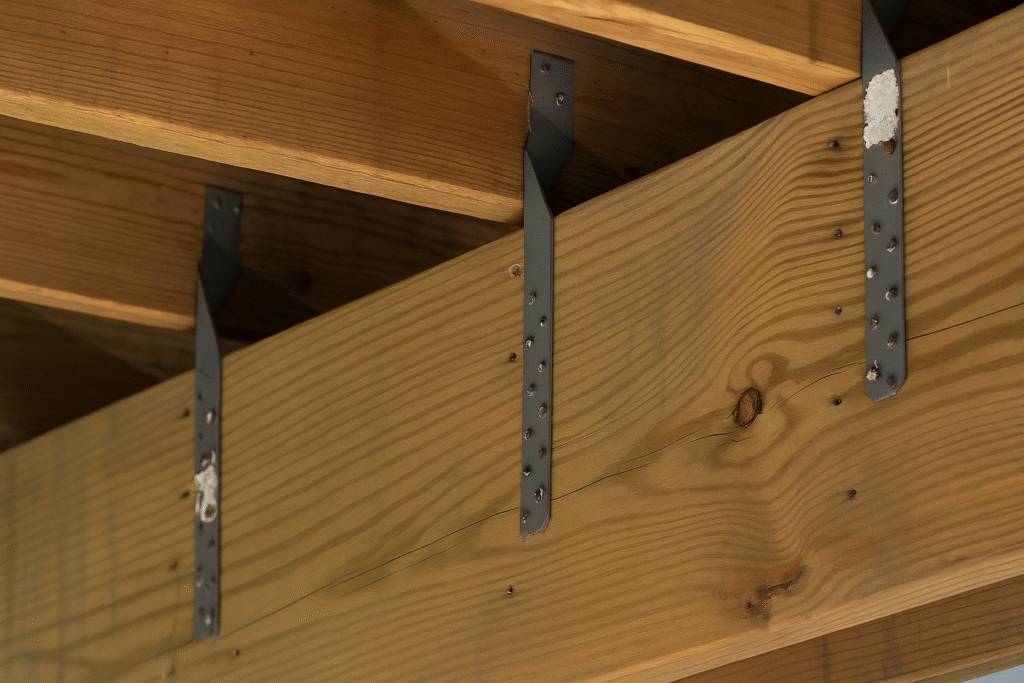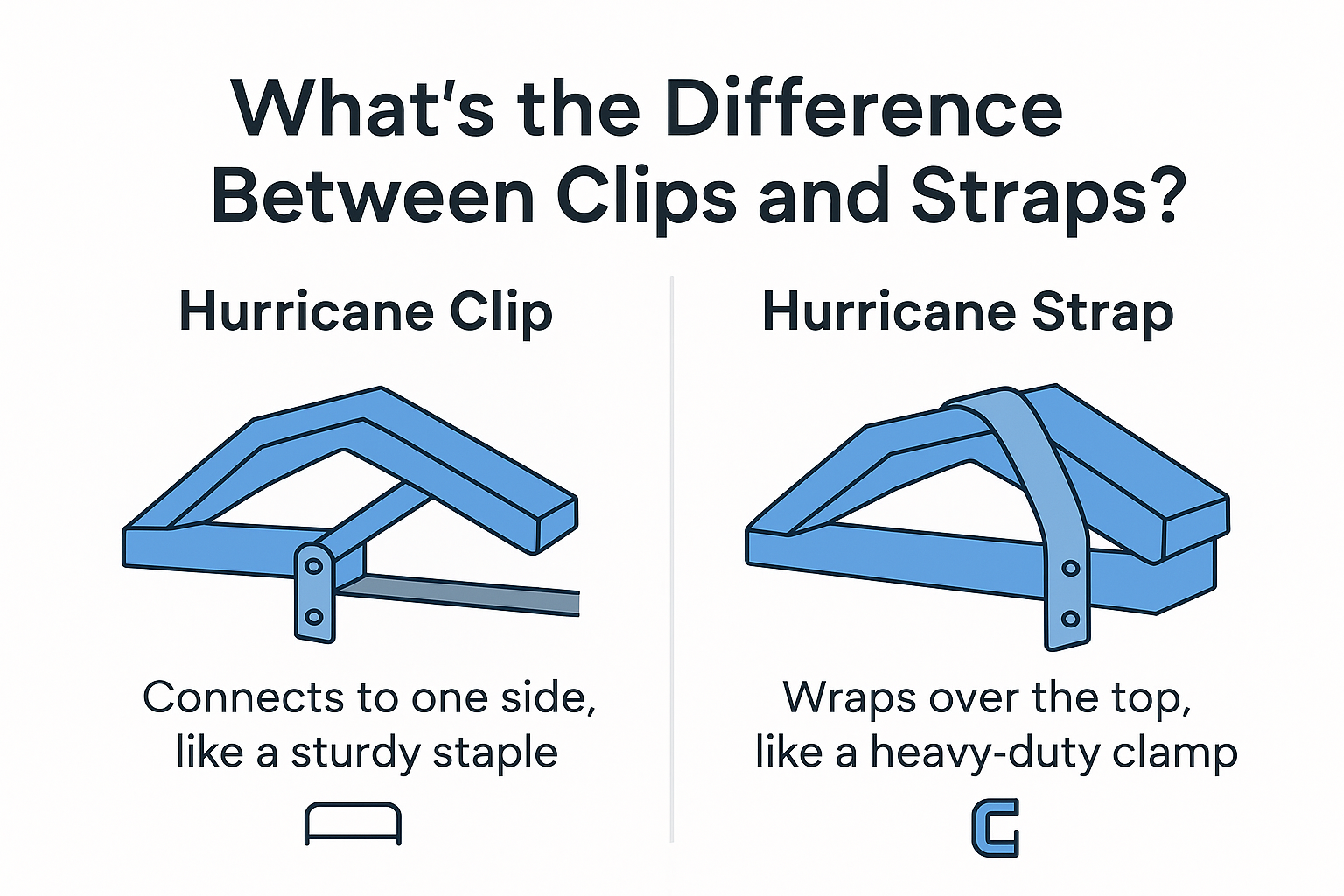A Homeowner’s Guide to Hurricane Clips and Straps in South Florida
Posted 10.14.2025 | 6 Minute Read

When you hear a hurricane is heading toward South Florida, the last thing you want to worry about is your roof. You may have heard neighbors or contractors mention “hurricane clips” and “hurricane straps,” but it can be confusing to know what they are and if your home needs them.
Understanding these small but mighty pieces of hardware is a key part of hurricane-proofing your roof and can even lower your insurance costs. This guide will walk you through everything you need to know.
What Are Hurricane Clips and Straps?
Hurricane clips and straps are metal connectors that anchor your roof’s structure to the walls of your home. Without them, your roof is typically held on by angled nails, which offer little resistance against the powerful forces of a hurricane.
A hurricane clip is a small, L-shaped bracket made of galvanized steel. It attaches to the side of the roof truss and the top of the wall, requiring at least three nails to be properly secured. This creates a solid connection that helps keep your roof in place.
A hurricane strap performs the same job but provides an even stronger connection. Instead of just attaching to one side, a strap wraps completely over the top of the roof truss like a belt. It is then nailed into the wall on both the front and back, giving your roof superior holding power against high winds.
What’s the Difference Between Clips and Straps?

While both connectors are designed to protect your roof, their design and application differ. Clips attach to one side of the truss and are often quicker to install during new construction. Straps, on the other hand, wrap entirely around the truss, creating a stronger, more secure connection. Because of their design, straps are often the preferred choice for retrofitting an existing home.
Think of it this way: a clip is like a sturdy staple, while a strap is like a heavy-duty clamp holding your roof down.
| Feature | Hurricane Clips | Hurricane Straps |
| Connection | Attaches to one side of the truss. | Wraps completely over the truss. |
| Strength | Good protection. | Stronger, more secure connection. |
| Best Use Case | New construction (faster installation). | Retrofitting existing homes; maximum protection. |
Why Does Your Roof Need This Protection?

During a hurricane, the wind doesn’t just push down on your roof—it creates a powerful upward suction, known as “uplift,” that can try to rip the roof right off your house. Hurricane clips and straps are engineered to counteract this force. By creating a continuous load path from the roof to the foundation, these metal connectors anchor your roof and keep it from lifting off during a storm.
Key takeaway: Hurricane clips and straps aren’t just for pushing back against wind—they’re designed to stop the powerful suction force that tries to lift your entire roof off during a storm.
Are Hurricane Connectors a Worthwhile Investment?
Yes, they are one of the smartest investments a South Florida homeowner can make. Properly installed clips or straps can help your roof withstand winds up to 150-160 mph, which covers most Category 4 hurricanes. This significantly reduces the risk of catastrophic roof failure. Beyond protection, these connectors offer a major financial benefit.
Save on Insurance: Installing proper roof-to-wall connections can save you up to 35% on your windstorm insurance premiums. Most homeowners find that the installation pays for itself within just a few years.
Finally, there’s the invaluable peace of mind. Knowing your roof is properly secured lets you focus on your family’s safety when a storm is approaching.
How Much Does It Cost to Install Hurricane Clips or Straps?
The cost depends on your home and the scope of the project. Individual clips typically cost between $0.50 and $1.50 each, while straps range from $1 to $3 each.
For installation, retrofitting an existing home can cost anywhere from a few thousand dollars up to $5,000, depending on your attic’s accessibility and your home’s design.
Pro Tip: The most affordable time to add hurricane clips or straps is during a roof replacement. Since your roofer already has access to the roof structure, the cost is significantly lower—usually between $1,000 and $2,000.
How Do You Get an Insurance Discount?
To qualify for insurance savings, you must have a wind mitigation inspection. A Florida-licensed inspector will visit your home to document its wind-resistant features, including the type of roof-to-wall connections you have. This official report is what you submit to your insurance company.
Important Note: Without a wind mitigation inspection report, you cannot qualify for the insurance discount, even if you have the proper clips or straps installed.
The inspection fee is a small one-time cost that quickly pays for itself in annual savings.
What If Your Home Doesn’t Have Them?
Many South Florida homes, especially those built before modern building codes were enforced, may lack adequate protection. Don’t worry—you have options. Sometimes, existing connectors just need an extra nail to meet current standards. In other cases, a contractor can perform an attic retrofit by installing straps from inside your home. If the attic isn’t accessible, the work can be done from the exterior by temporarily removing the soffits.
Take the Next Step to Protect Your Home
The time to think about your roof’s safety is now, not when a hurricane warning is issued. By then, it’s too late to make improvements.
Coastal Roofing of South Florida is here to help you get prepared. We can:
- Schedule a thorough roof inspection.
- Determine if your current roof-to-wall connections meet code.
- Add or upgrade hurricane clips or straps to secure your home.
- Provide the documentation you need for insurance discounts.
We are a trusted local company that understands South Florida’s unique building codes and insurance requirements. Our goal is to give you honest advice and effective solutions to protect your home and family.
Ready to make sure your roof is storm-ready? Contact Coastal Roofing of South Florida today for a free, no-pressure inspection. We’ll walk you through exactly what your home needs and help you feel confident in your roof’s ability to weather any storm.
Recent Articles
